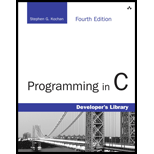
The least common multiple (1cm) of two positive integers u and v is the smallest positive integer that is evenly divisible by both u and v. Thus, the 1cm of 15 and 10, written lcm (15, 10), is 30 because 30 is the smallest integer divisible by both 15 and 10. Write a function 1 that takes two integer arguments and returns their 1cm. The 1 function should calculate the least common multiple by calling the g function from
lcm (u, v) = uv / gcd (u, v) u, v >= 0
Want to see the full answer?
Check out a sample textbook solution
Chapter 7 Solutions
Programming in C
Additional Engineering Textbook Solutions
Problem Solving with C++ (10th Edition)
Starting Out with C++ from Control Structures to Objects (9th Edition)
Starting Out with Java: From Control Structures through Objects (7th Edition) (What's New in Computer Science)
Degarmo's Materials And Processes In Manufacturing
Computer Science: An Overview (13th Edition) (What's New in Computer Science)
Introduction To Programming Using Visual Basic (11th Edition)
 C++ for Engineers and ScientistsComputer ScienceISBN:9781133187844Author:Bronson, Gary J.Publisher:Course Technology Ptr
C++ for Engineers and ScientistsComputer ScienceISBN:9781133187844Author:Bronson, Gary J.Publisher:Course Technology Ptr C++ Programming: From Problem Analysis to Program...Computer ScienceISBN:9781337102087Author:D. S. MalikPublisher:Cengage LearningCOMPREHENSIVE MICROSOFT OFFICE 365 EXCEComputer ScienceISBN:9780357392676Author:FREUND, StevenPublisher:CENGAGE L
C++ Programming: From Problem Analysis to Program...Computer ScienceISBN:9781337102087Author:D. S. MalikPublisher:Cengage LearningCOMPREHENSIVE MICROSOFT OFFICE 365 EXCEComputer ScienceISBN:9780357392676Author:FREUND, StevenPublisher:CENGAGE L- Np Ms Office 365/Excel 2016 I NtermedComputer ScienceISBN:9781337508841Author:CareyPublisher:Cengage



